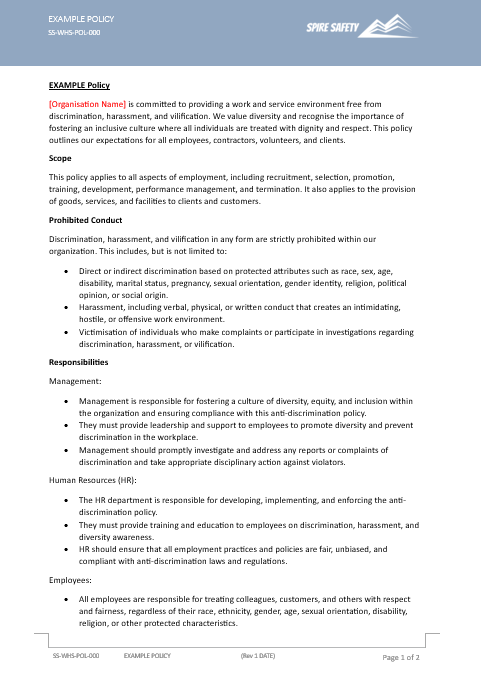Free Anti-Discrimination Policy Template
Download our Free Anti-Discrimination Policy Template:
*For internal use only. Not for resale or redistribution. By downloading, you agree to our Free Resources Licensing Agreement
 Purpose of an Anti-Discrimination Policy
Purpose of an Anti-Discrimination Policy
An Anti-discrimination Policy outlines the framework and expectations related to anti-discrimination. These policies aim to manage risks and hazards associated with discrimination and create a safe and healthy working environment.
How to Use
This Anti-Discrimination Policy template should be customised by a competent person, signed by a top-level manager (e.g. the director), and displayed in the workplace or provided by other means (e.g. website). It should also be communicated to new workers as part of their induction or onboarding process.
This document is a template only and it must be customised for your business. Other aspects that need to be considered include ensuring that:
- Relevant legal requirements have been met,
- Workplace specific risks are identified and managed, and
- Workers are consulted with during the customisation / review process.
When to Use
This document should be displayed in a prominent area or provided by other means (e.g. website). You should also use it during employee inductions, and you may wish to refresh your workers on the contents of the policy periodically as part of a safety meeting or refresher training.
Who Should Use
This document should be endorsed with the signature of the appropriate top-level manager (such as a director). It can be used by your Safety Advisor, Project Manager, or other Manager/s to communicate the requirements to workers (including new workers).
Legal Considerations
Generally, under the WHS legislation, there is no specific legal requirement to have or display an Anti-Discrimination Policy. However, it is best practice. It can help meet general legal duties, including:
s(19)(3)a WHS Act – Duty to Provide a Safe Working Environment
Workers also have legal responsibilities, including:
- s(28) WHS Act – Duty of workers:
- Taking care of yourself
- Taking care of others
- Following procedure
- Following instruction
FAQ
What is an Anti-Discrimination Policy?
An Anti-Discrimination Policy is a set of guidelines or rules implemented by organizations or governments to prevent discrimination based on factors such as race, gender, age, disability, sexual orientation, religion, or other protected characteristics.
Why are Anti-Discrimination Policies important?
Anti-Discrimination Policies promote equality, fairness, and inclusivity by ensuring all individuals are treated with respect and afforded the same opportunities regardless of their background or characteristics.
How do Anti-Discrimination Policies protect against discrimination?
Anti-Discrimination Policies outline prohibited behaviors, provide mechanisms for reporting discrimination, and establish procedures for addressing complaints.
Did you know?
Australia was one of the first countries to introduce comprehensive anti-discrimination legislation at the federal level in 1975, through the Racial Discrimination Act. This landmark legislation set the stage for further protections against discrimination based on race, gender, age, disability, and other factors, solidifying Australia’s commitment to promoting equality and diversity.
Article Sources and Further Reading
- The Complete Guide to WHS Policies and Procedures in Australia (Spire Safety) <https://spiresafety.com.au/resources/guide-to-whs-policies-and-procedures/>
- What is a WHSMS (Work Health and Safety Management System)? (Spire Safety) <https://spiresafety.com.au/resources/what-is-a-whsms/>
- Work Health and Safety Policy (Safe Work NSW) <https://www.nsw.gov.au/enterprise-investment-trade/policy/work-health-and-safety>

 Purpose of an Anti-Discrimination Policy
Purpose of an Anti-Discrimination Policy